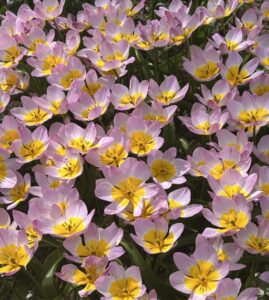 In 1957, Elizabeth Lawrence, a great American gardener and garden writer published The Little Bulbs: A Tale of Two Gardens. It is a small book, as befits its subject, but eloquent on the topic of small plants and big friendships. The Little Bulbs is still available from used book outlets and is well worth investigating.
In 1957, Elizabeth Lawrence, a great American gardener and garden writer published The Little Bulbs: A Tale of Two Gardens. It is a small book, as befits its subject, but eloquent on the topic of small plants and big friendships. The Little Bulbs is still available from used book outlets and is well worth investigating.
It is time to think about fall-planted bulbs and, inspired by Ms. Lawrence, I am considering some small ones. Last year I bought a number of small daffodil varieties, and this year I find my thoughts straying into the realm of species tulips, which are sometimes small in stature and a bit more “wildflowery” than some of their flashier relatives. They also tend to perennialize readily, a plus for those of us who occasionally tire of treating relatively expensive tulip varieties as annuals.
I am drawn to the Clusianas or “lady tulips”. Native to parts of the Middle East and western Asia, clusianas were named for Carolus Clusius, a renowned sixteenth century physician, botanist, and plant hunter who specialized in tulips. His namesake species tulips grow 10 to 12 inches tall on slender stems, accented with gray-green leaves. Atop those stems are vase-shaped flowers that open into wide stars in the March sunshine.
I am especially partial to ‘Peppermint Stick’, The inner petals are white and the outer petals, a glowing red, giving rise to the varietal name. When the flowers are fully open, you can see purple centers at the heart of each one.
For a bit of contrast, I am also investing in ‘Tubergen’s Gem’, another bi-colored clusiana that combines red outer petals with yellow interior ones.
Most of the commercially available clusianas are bi-colors, and are available in mixtures, as well as single variety selections.
Thomas Jefferson grew Tulipa sylvestris, also known as Florentine or woodland tulips, which were originally discovered in their native central Asian habitats. The sylvestris tulips are about the same height as the clusianas, but have the added benefit of being fragrant, which is an appealing quality at any time of year. The flowers are golden yellow, with greenish exterior petals. The slender stems wave in the spring breezes.
In keeping with the “sylvestris” name, these tulips love woodland edges or semi-shaded areas.
‘Lilac Wonder’, a variety of Tulipa bakeri, is one of the best known species tulips. Perfect for containers, border edges, window boxes, or rock gardens, it grows only about seven inches tall, with lavender-pink petals that open to large yellow centers. It is noted for being one of the longest-blooming of the species tulips, which is lovely in the spring when small-flowered species seem to come and go too quickly.
Slightly taller, at 14 to 16 inches, and later blooming, is the wild and crazy-looking Tulipa acuminata, which some merchandisers have dubbed the “fire flame tulip”. Its petals are yellow, striped and tipped in scarlet, but the configuration is the selling point. Emanating from the typical bowl or vase-shaped bases, the petals reach skyward, narrowing as they ascend until the ends form sharp points. When the blooms are fully open, they look like brilliant six-legged spiders. The effect of a mass planting is small-scale garden fireworks display.
Tulipa humilis is another very small species, growing to only about six inches. The blooms are so pretty that they invite a closer look. One of the best known varieties is ‘Alba Coerulea Occulata’ which has six plump white petals that open out to reveal a wide, blue-purple center. ‘Persian Pearl’ has the same flower form, but features purple-magenta petals that open to reveal golden yellow centers.
All tulips like to be planted six to eight inches deep in rich, well-drained soil, and that is especially true of the species tulips, which will perennialize most readily under those conditions. Sadly, they may be as attractive to deer and other garden marauders as their larger, hybrid tulip relations. You can deal with this by growing the tulips in pots or window boxes where deer cannot get to them, and/or by spraying them regularly with deer repellant. I will do both, ensuring that I will have some to look at next spring.
The little tulips are a great bargain, costing much less per bulb than hybrid varieties. Think of planting them en masse, like crocuses, rather than one by one. Sometimes you can also confuse deer by interplanting with small daffodil varieties, which deer and rodents don’t like.
Find a good assortment of species tulips at John Scheepers, 23 Tulip Drive,
P.O. Box 638, Bantam, CT 06750; (860) 567-0838; www.johnscheepers.com. For larger quantities, go to Van Engelen, which is a sister company at the same address. Both offer print catalogs.
.
